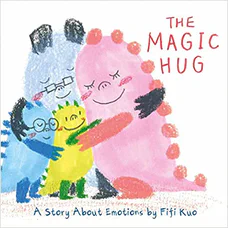The Magic Hug
A Story About Emotions

Recommended Age Range: Preschool through 1st grade.
Publisher's Summary:
What happens when a little dragon gets angry? She FLAMES red-hot . . . and things get burnt. Then she feels sad and lonely. Through this adorable character, Magic Hug explores the powerful feeling of anger, showing how it affects us and everyone we love. But it also offers a loving and simple solution: hug your anger away!

Dr. Annie's Takeaways
Recommended for: For children, this book provides reassurance that even when their anger gets the best of them, their parents still love them, and a hug can really help. For adults, this book is a short, emotionally vibrant reminder that when children “flame” and destroy things, it’s a scary, lonely experience for them, and they often need a hug.
Would a child like it? The images in this book could be a bit scary for some very young children, and it’s pretty dark for a couple of pages in the middle. But a child who relates to this story will likely love the ending and the reminder that they are still loved even when their temper flames.
Evidence-Based Practices:
Emotional Literacy
Tone: Emotionally intense–initially angry, then dark, and ultimately warm and sweet
Story Quality: Written in first person, this is a simple story with very few words, but it effectively captures the experience of a child in a rage, followed by the sadness afterwards, and it ends on a loving note.
Illustrations: Childlike crayon drawings of a family of dragons (to me they look more like little monsters than dragons). The dragon’s anger is shown as bold red lines of fire shooting from the dragon’s mouth.
Representation: The little dragon is not gendered in the story; in the publisher’s summary she/her pronouns are used. She has parents who appear to be a mom and a dad (they are drawn as pink and blue dragons) as well as a brother.
Psychological Practices: This story uses emotion labels to describe the experience of feeling angry (“I flame!”), followed by feelings of loneliness and guilt, and ultimately feelings of warmth, calm, and peace when the little dragon’s mother hugs her. The little dragon doesn’t know why she’s angry, but she is, and she burns things that matter (her dad’s flower garden, her mom’s favorite chair, her brother’s toys, even her reflection in the mirror). After everything is burned, she feels really terrible. This two-page spread is filled with black crayon, and it’s a heart-breaking reminder of how awful children often feel following a tantrum. She is saved from this dark place by her mother who scoops her up in a hug and brings her back to a place of calm. As much as we like to teach children strategies for calming their rage, it can take a while for children to learn to use these tools, and some children continue to struggle with their temper even after learning all of the anger management strategies that exist. I love that this book reminds children that they are loved even when they “flame” and burn things, and it reminds parents that sometimes these moments are when children most need love.
Concerns: None.
